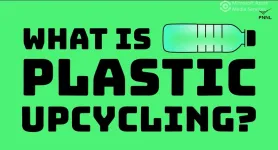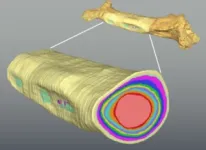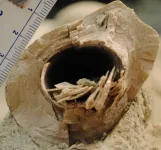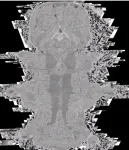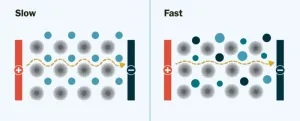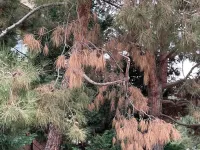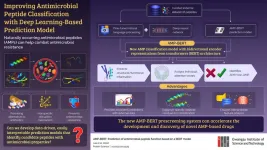(Press-News.org) RICHLAND, Wash.—There’s a lot of potentially useful raw materials bound up in used face masks, grocery bags and food wrap. But it has been much cheaper to keep making more of these single-use plastics than to recover and recycle them.
Now, an international research team led by the Department of Energy’s Pacific Northwest National Laboratory has cracked the code that stymied previous attempts to break down these persistent plastics. They reported their discovery in today’s issue of Science.
Low temperature and reaction control
Typically, recycling plastics requires ‘cracking’ or splitting apart the tough and stable bonds that also make them so persistent in the environment. This cracking step requires high temperatures, making it expensive and energy intensive.
The novelty here is combining the cracking step with a second reaction step that immediately completes the conversion to a liquid gasoline-like fuel without unwanted byproducts. The second reaction step deploys what are known as alkylation catalysts. These catalysts provide a chemical reaction currently deployed by the petroleum industry to improve the octane rating of gasoline.
Crucially in the current study, the alkylation reaction immediately follows the cracking step in a single reaction vessel, near room temperature (70 degrees C/158 degrees F).
“Cracking just to break the bonds results in them forming another one in an uncontrolled way, and that's a problem in other approaches,” said Oliver Y. Gutiérrez, a study author and chemist at PNNL. “The secret formula here is that when you break a bond in our system, you immediately make another one in a targeted way that gives you the end product you want. That is also the secret that enables this conversion at low temperature.”
In their study, the research team, co-led by scientists from the Technical University of Munich, Germany, pointed to separate, recent developments by the petroleum industry to commercialize the second part of the process reported here for crude oil processing.
“The fact that industry has successfully deployed these emerging alkylation catalysts demonstrates their stable, robust nature,” said Johannes Lercher, a senior author of the study, director of PNNL’s Institute for Integrated Catalysis, and professor of chemistry at TUM. “This study points to a practical new solution to close the carbon cycle for waste plastic that is closer to implementation than many others being proposed.”
In their study, the researchers note a limitation on their findings. The process works for low-density polyethylene products (LDPE, plastic resin code #4), such as plastic films and squeezable bottles, and polypropylene products (PP, plastic resin code #5) that are not typically collected in curb-side recycling programs in the United States. High-density polyethylene (HPDE, plastic resin code #2) would require a pretreatment to allow the catalyst access to the bonds it needs to break.
Seeing waste plastic as future fuel and new products
Petroleum-based plastic waste is an untapped resource that can serve as the starting material for useful durable materials and for fuels. More than half of the 360 million tons of plastics produced globally each year are the plastics targeted in this study. But looking at a mountain of plastic and seeing its value requires an innovator’s mindset, a chemist’s ingenuity, and a realist’s understanding of the economics involved. These scientists are trying to change the dynamic by applying their expertise in efficiently breaking chemical bonds.
“To solve the problem of persistent waste plastic, we need to reach a critical point where it makes more sense to collect it and return it to use than to treat it as disposable,” said Lercher. “We’ve shown here that we can make that conversion quickly, at mild conditions, which provides one of the incentives to move forward to that tipping point.”
This research study, published Feb. 24, 2023, was supported by the Department of Energy Office of Science.
END
Plastic upcycling to close the carbon cycle
A new PNNL-developed process produces fuel quickly at mild temperature, with few byproducts
2023-02-23
ELSE PRESS RELEASES FROM THIS DATE:
Evolution of dinosaur body size through different developmental mechanisms
2023-02-23
The meat-eating dinosaurs known as theropods that roamed the ancient Earth ranged in size from the bus-sized T. rex to the smaller, dog-sized Velociraptor. Scientists puzzling over how such wildly different dinosaur sizes evolved recently found – to their surprise– that smaller and larger theropod dinosaurs like these didn’t necessarily get that way merely by growing slower or faster.
In a new paper published in Science, “Developmental strategies underlying gigantism and miniaturization ...
MoBIE enables modern microscopy with massive data sets
2023-02-23
High-resolution microscopy techniques, for example electron microscopy or super-resolution microscopy, produce huge amounts of data. The visualization, analysis and dissemination of such large imaging data sets poses significant challenges. Now, these tasks can be carried out using MoBIE, which stands for Multimodal Big Image Data Exploration, a new user-friendly, freely available tool developed by researchers from the University of Göttingen and EMBL Heidelberg. This means that researchers such as biologists, who rely ...
$3M NIH grant will fund next steps of research on dance and brain health
2023-02-23
WINSTON-SALEM, N.C. – Feb. 23, 2023 – Wake Forest University and Wake Forest University School of Medicine will receive $3 million over five years from the National Institutes of Health (NIH) to help researchers take the next steps in nearly a decade of research that indicates dance can promote cognitive health.
The grant funds a new study called IGROOVE that will help researchers determine what kinds of dance, the frequency of the dance classes and what aspects of the dance class – music, social interaction, cognitive challenge – affect fitness, memory and brain health.
The research will be co-led by Christina ...
UC Irvine researchers create E. coli-based water monitoring technology
2023-02-23
Irvine, Calif., Feb. 23, 2023 – People often associate Escherichia coli with contaminated food, but E. coli has long been a workhorse in biotechnology. Scientists at the University of California, Irvine have demonstrated that the bacterium has further value as part of a system to detect heavy metal contamination in water.
E. coli exhibit a biochemical response in the presence of metal ions, a slight change that researchers were able to observe with chemically assembled gold nanoparticle optical sensors. Through a machine-learning ...
New $2.9 million grant helps researchers address food insecurity for Hoosiers
2023-02-23
INDIANAPOLIS—With a $2.9 million grant from the National Institute on Minority Health and Health Disparities, researchers from Indiana University School of Medicine are working to improve food insecurity in Indiana and ultimately improve the health of people in Indiana.
Individuals who experience food insecurity–inconsistent access to affordable and nutritious food–are more susceptible to a variety of health conditions, including hypertension and Type 2 Diabetes. The FoRKS: Food Resources ...
On the road to better solid-state batteries
2023-02-23
A team from Lawrence Berkeley National Laboratory (Berkeley Lab) and Florida State University has designed a new blueprint for solid-state batteries that are less dependent on specific chemical elements, particularly critical metals that are challenging to source due to supply chain issues. Their work, reported recently in the journal Science, could advance solid-state batteries that are efficient and affordable.
Touted for their high energy density and superior safety, solid-state batteries could be a game-changer for the electric car industry. ...
National Center to Reframe Aging welcomes 16 to new advisory board
2023-02-23
The National Center to Reframe Aging — the nation’s leading organization dedicated to reshaping the conversation about older people — has established a new advisory board with 16 members from such diverse professional backgrounds as communications and public relations, research, policy, and law.
These board members were tapped to bring knowledge, strategic thinking, and interpersonal attributes to their role; to identify key organizations and decision-makers who can help advance the initiative; and support activities aligning with National Center project goals.
“We look forward to working with this talented group of advisors to grow ...
Heterostructures developed at Purdue support predictions of counterpropagating charged edge modes at the v=2/3 fractional quantum Hall state
2023-02-23
In 2018, a team of physicists at Purdue University invented a device which experimentally showed quasiparticles interfering for the first time in the fractional quantum Hall effect at filling factor v=1/3. Further development of these heterostructures has allowed the Manfra Group to expand their research to experiments that explore counterflowing charged edge modes at the 2/3 fractional quantum Hall state.
They have recently published their findings, “Half-Integer Conductance Plateau at the ν = 2/3 Fractional Quantum Hall State in a Quantum Point Contact,” in Physical Review Letters on February 17, 2023. This ...
Fungi that causes pine ghost canker detected in southern California trees
2023-02-23
Fungal pathogens that cause die-back in grape, avocado, citrus, nut and other crops has found a new host and is infecting conifer trees causing Pine Ghost Canker in urban forest areas of Southern California.
The canker can be deadly to trees.
Scientists from University of California, Davis, first spotted evidence that the pathogens had moved to pines during a routine examination of trees in Orange County in 2018. Over four years, they found that more than 30 mature pines had been infected in an area of nearly 100 acres, according ...
GIST researchers develop “AMP-BERT”: A new AI-based “finder” of antimicrobial peptides
2023-02-23
Over the last few decades, antimicrobial resistance has become a major public health concern globally. This has led to a search for alternative methods of treating microbial infections. One such innovation is the discovery of antimicrobial properties of certain peptides. Antimicrobial peptides (AMPs) are short peptides found in most animals, plants, and microorganisms as a natural defense against infections. AMPs combat harmful bacteria via a nonspecific mechanism that prevents them from developing antimicrobial resistance. Despite these exceptional abilities, research on AMPs is being hindered because the existing systems for identifying candidate ...
LAST 30 PRESS RELEASES:
Norbert Holtkamp appointed director of Fermi National Accelerator Laboratory
New agentic AI platform accelerates advanced optics design
Biologists discover neurons use physical signals — not electricity — to stabilize communication
Researchers discover that a hormone can access the brain by hitchhiking
University of Oklahoma researcher awarded funding to pursue AI-powered material design
Exploring how the visual system recovers following injury
Support for parents with infants at pediatric check-ups leads to better reading and math skills in elementary school
Kids’ behavioral health is a growing share of family health costs
Day & night: Cancer disrupts the brain’s natural rhythm
COVID-19 vaccination significantly reduces risk to pregnant women and baby
The role of vaccination in maternal and perinatal outcomes associated with COVID-19 in pregnancy
Mayo Clinic smartwatch system helps parents shorten and defuse children's severe tantrums early
Behavioral health spending spikes to 40% of all children’s health expenditures, nearly doubling in a decade
Digital cognitive behavioral treatment for generalized anxiety disorder
Expenditures for pediatric behavioral health care over time and estimated family financial burden
Air conditioning in nursing homes and mortality during extreme heat
The Alps to lose a record number of glaciers in the next decade
What makes a good proton conductor?
New science reporting guide published for journalists in Bulgaria
New international study reveals major survival gaps among children with cancer
New science reporting guide published for journalists in Turkey
Scientists develop a smarter mRNA therapy that knows which cells to target
Neuroanatomy-informed brain–machine hybrid intelligence for robust acoustic target detection
Eight SwRI hydrogen projects funded by ENERGYWERX
The Lundquist Institute and its start-up company Vitalex Biosciences Announces Strategic Advancement of Second-Generation fungal Vaccine VXV-01 through Phase 1 Trials under $40 Million Competitive Con
Fine particles in pollution are associated with early signs of autoimmune disease
Review article | Towards a Global Ground-Based Earth Observatory (GGBEO): Leveraging existing systems and networks
Penn and UMich create world’s smallest programmable, autonomous robots
Cleveland researchers launch first major study to address ‘hidden performance killer’ in athletes
To connect across politics, try saying what you oppose
[Press-News.org] Plastic upcycling to close the carbon cycleA new PNNL-developed process produces fuel quickly at mild temperature, with few byproducts

